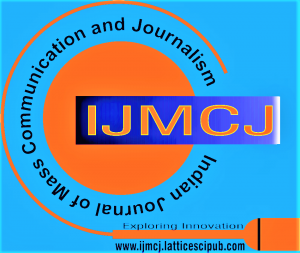![]()
The Development of Journalism in the Face of Social Media – A Study on Social Media’s Impact on a Journalist’s Role, Method, and Relationship to the Audience
Ayushi Jain1, Ashok Kumar Meena2
1Ms. Ayushi Jain, PhD Scholar, Department of Journalism and Mass Communication, University of Technology, Jaipur (Rajasthan), India.
2Dr. Ashok Kumar Meena, Professor, Department of Journalism and Mass Communication, University of Technology, Jaipur (Rajasthan), India.
Manuscript received on 09 October 2024 | Revised Manuscript received on 29 October 2024 | Manuscript Accepted on 15 December 2024 | Manuscript published on 30 December 2024 | PP: 8-14 | Volume-4 Issue-2, December 2024 | Retrieval Number: 100.1/ijmcj.B111104021224 | DOI:10.54105/ijmcj.B1111.04021224
Open Access | Editorial and Publishing Policies | Cite | Zenodo | OJS | Indexing and Abstracting
© The Authors. Published by Lattice Science Publication (LSP). This is an open-access article under the CC-BY-NC-ND license (http://creativecommons.org/licenses/by-nc-nd/4.0/)
Abstract: This article explores how social media has changed journalism, with a particular emphasis on how it has affected reporters’ roles, techniques, and interactions with audiences. Social media sites like Facebook, Instagram, and Twitter have given journalists new opportunities as well as difficulties [1]. These platforms’ introduction has sped up news cycles and moved the emphasis from in-depth reporting to quick, snappy content creation [2]. As a result of this change, journalists must learn to work in a faster-paced news environment and handle the challenges of information overload and source verification [vi]. Both qualitative and quantitative research methodologies are used in this study. Ten journalists participated in in-depth interviews to collect qualitative data, which showed how social media has drastically changed traditional reporting practices by requiring a balance between accuracy and speed [12]. The spread of false information and the pressure to give sensationalism top priority in order to achieve high engagement metrics have been identified as major obstacles [13]. Variations in the frequency of audience interaction, the number of platforms used, and the reliance on social media for news sourcing are highlighted by quantitative analysis based on surveys of 250 journalists. According to the research, social media is heavily relied upon by journalists, with 27.2% of them utilising it for 41–60% of their news sourcing and differing degrees of audience interaction. “The ethical ramifications of social media in journalism are also examined in the study.” While some journalists discover that social media improves audience engagement and speeds up the distribution of news, others worry about the detrimental effects on journalistic ethics and integrity. According to the study’s findings, social media can increase interaction and immediacy, but it can also make it difficult to uphold ethical standards and accuracy.
Keywords: Social Media, Journalist, Relationship, Media Impact, Audience, Journalism, Etc.
Scope of the Article: Journalistic Professionalism
